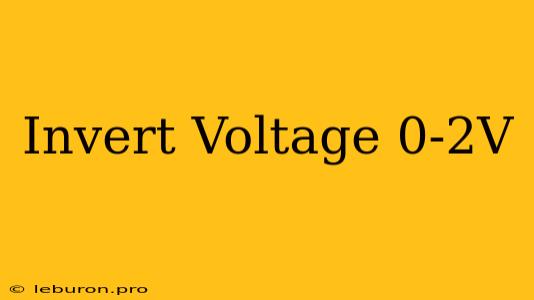Inverting Voltage in the 0-2V Range: Techniques and Applications
In the realm of electronics, manipulating voltage levels is a fundamental task, often requiring the conversion of signals from one range to another. A common scenario involves inverting a voltage signal within a specific range, such as 0-2V. This article delves into various techniques for inverting voltage within this specific range, exploring their functionalities, advantages, and limitations.
Understanding the Concept of Voltage Inversion
Voltage inversion is the process of transforming a voltage signal into its opposite polarity. In essence, it flips the signal across a reference point, typically ground (0V). For example, if a voltage signal is 1V, inverting it would result in -1V. This inversion is essential in numerous electronic circuits, such as:
- Signal Conditioning: Inverting signals is crucial for adapting signals to the requirements of different circuit components.
- Logic Gates: Inverters play a fundamental role in digital logic circuits, enabling signal negation.
- Feedback Control Systems: Inversion is often employed in feedback loops to stabilize and optimize system performance.
Techniques for Inverting Voltage within the 0-2V Range
Several approaches can be used to invert voltage signals within the 0-2V range. Here are some of the most prevalent techniques:
1. Operational Amplifier (Op-Amp) based Inverters:
Operational Amplifiers: The Foundation of Inversion
Op-amps are versatile analog circuit building blocks, renowned for their ability to amplify, buffer, and invert signals. Their high gain and low output impedance make them ideal for precise voltage inversion. A simple inverting amplifier circuit can be constructed using an op-amp with a feedback resistor and an input resistor. The inverting input terminal of the op-amp receives the input voltage, while the non-inverting input is connected to ground. The feedback resistor connects the op-amp's output to its inverting input, forming a negative feedback loop.
2. Voltage Divider with a Constant Reference:
Creating a Virtual Ground:
This method utilizes a simple voltage divider network to achieve voltage inversion. A voltage divider is composed of two resistors connected in series. One end of the divider is connected to the input voltage, while the other end is connected to a constant reference voltage. By selecting appropriate resistor values, the voltage at the junction between the two resistors can be made to equal the inverted input voltage. The constant reference voltage acts as a virtual ground, enabling the inversion.
3. Using a Bipolar Junction Transistor (BJT):
Leveraging the BJT's Current Amplifying Properties:
BJTs, commonly used for amplifying and switching, can also be employed for inverting voltage signals. A common emitter BJT configuration, along with appropriate biasing resistors, can be utilized to achieve inversion. The input signal is applied to the base of the BJT, and the output is taken from the collector. The emitter is connected to ground.
4. Digital Inverters:
Logic Gates for Efficient Inversion:
Digital inverters, such as NOT gates, are specifically designed to invert binary signals. They typically operate on logic levels, such as 0V for a logic low and 5V for a logic high. However, by adjusting the input voltage range and using appropriate logic levels, they can effectively invert signals within the 0-2V range.
Applications of Inverting Voltage within the 0-2V Range:
Inverting voltage signals within the 0-2V range finds numerous applications in various domains, including:
- Analog-to-Digital Converters (ADCs): ADCs often require a specific input voltage range, and inverting the signal ensures it falls within the desired range.
- Sensors and Transducers: Sensors may produce signals outside the expected range; inverting the signal can adjust it for proper processing.
- Signal Filtering and Processing: Inverting signals can be used for filtering and signal conditioning before further processing.
- Data Transmission and Communication: Inverting signals can be used in communication systems to ensure proper data transmission and reception.
Choosing the Right Technique:
The choice of the most appropriate voltage inversion technique depends on several factors, including:
- Voltage Range: Ensure the selected technique can handle the desired input voltage range.
- Accuracy: The desired accuracy of the inversion process will influence the choice of technique.
- Power Consumption: Consider the power requirements and efficiency of the chosen method.
- Cost and Complexity: The cost and complexity of implementing the solution should be considered.
Conclusion:
Inverting voltage within the 0-2V range is a fundamental operation in numerous electronic applications. Techniques such as op-amp based inverters, voltage dividers with constant references, BJT configurations, and digital inverters provide versatile solutions for achieving this task. By understanding the principles and applications of these techniques, designers can effectively implement voltage inversion to meet the specific requirements of their circuits, enabling them to manipulate and control signals within the 0-2V range.
